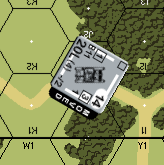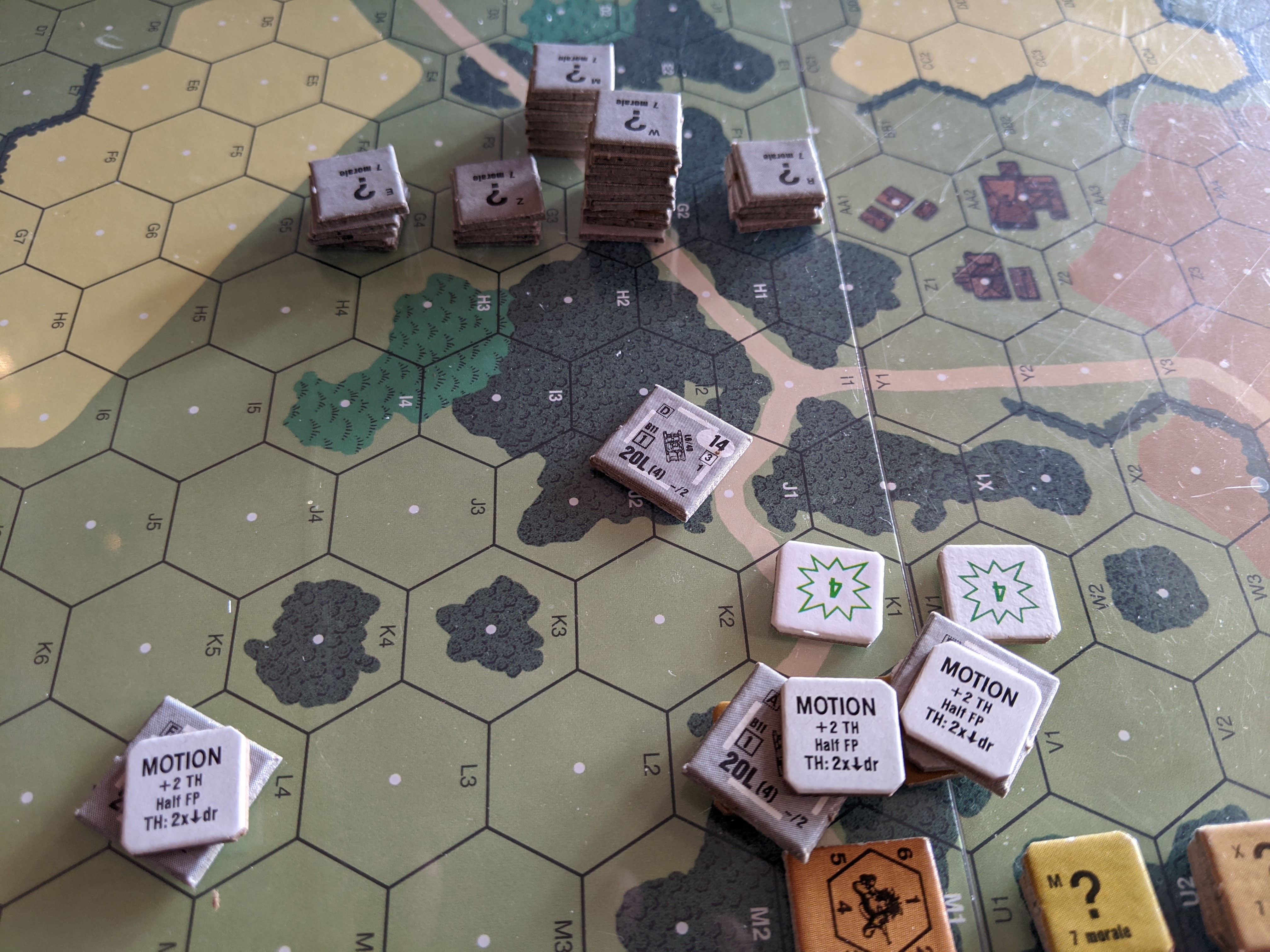This article has been deprecated by a revision to the Q&A which formed the basis of this article. I have struck through the portion of the article which is no longer correct. I am also including the Q&A submitted by Robert Hammond to clarify the current state of the game.
July 2023 Revised Q&A
“I read Jim Bishops’ article on vehicles in woods (dtd 9 March 2022). I was troubled by his answer for an AFV on a woods-road changing its VCA.
“Jim stated the AFV would pay 2 MP for changing its VCA across a non-road hexside while in woods (last sentence of rule B13.41). Jim continues to assert that rule D2.11 also applies. It appears there is posted clarification / Q&A on this subject. I wrote to Klas about this, and he directed me to write to you.
“I disagree with combining both rules. Here is why.
“Rule D2.11, the third sentence states in pertinent part, “. . . two MP per hexspine change if actually in . . . woods”. [emphasis mine] From a grammatical standpoint, this sentence is implying that the AFV must be IN woods. Moreover, this is also why this same rule makes the distinction of an AFV being in bypass (thus not in the woods) and not paying more MP!
“QUESTION: Is an AFV on a woods-road actually in woods? (I do not think so.) The AFV is in a woods hex, but not in the woods. Moreover, if the LOS is traced solely along the road to the AFV while it is moving, the AFV receives no woods TEM (B13.31, first sentence). Also, a stopped AFV on a woods-road never receives wood’s TEM unless on a partial TB (B13.31, in the exception which is in the last sentence). Thus, if the AFV is not currently receiving wood’s TEM, rule D2.11 cannot apply.
“REQUEST FOR RECONSIDERATION: I am therefore requesting a reconsideration of the posted answer that an AFV would expend 4 MP to change its VCA on a woods-road across a non-road hexside. I believe it should only cost 2 MP and rule D2.11 should not apply.”
His question and Perry’s answer are:
Question: What does it cost an AFV on the road in a wood-road hex to change VCA across a non-road hexside?
A. 2 MP. This revises our prior answer of 4 MP.

Today I am starting a new series in which I explain various rules gaffes I make in the course of playing ASL. As my play isn’t super regular, articles in this series will be sporadic. Today’s example comes from a game I played with Joe Arthur at Heroes. We were playing J130 The Art of Dying when the two situations described below came up. Let’s see what Jim got wrong, shall we?
Map Overview

I am providing this image here so you can see the terrain itself without counters. In the following two examples, there will be counters in play. This makes it difficult to see the terrain and obscures the point I am making. Hopefully this inclusion will make everything clear.
Mistake 1: Proper MPs

In this example, Joe is moving his L6/40 along a Woods-Road. Upon entering the Location, Joe announced a turn of 1 hex side clockwise for 1 MP. I was fairly certain this was wrong but I couldn’t recall where the rule was supporting my position. I was convinced the MPs are doubled for changing the VCA across a non-Road hexside. With the benefit of time, I can now confirm I was right and the rule is B13.41 (All MP penalties for entering a hex containing a wreck/vehicle, and/or for changing a VCA across a non-road hexside, are doubled while in a woods hex.)
But I was also wrong. I NEVER remember D2.11 (two MP per hexspine change if actually in [not in bypass of] a building/woods/rubble or any combination thereof). So the actual cost of changing VCA in a Woods-Road Location across a non-Road hex side is 4 MPs.
Mistake 2: Exiting A Woods-Road Location Via A Non-Road Hexside

Joe continued to move his AFV into J1 and announced a move to K2 for 1 MP. Again, I was pretty sure this required exiting the Road into the Woods portion of J1 but couldn’t find the rule supporting it. If you look at the map overview image above it seems like Joe’s move should be allowed. Since I couldn’t show an actual rule at the time, I allowed the move. I don’t like to stop people from doing something if I can’t prove it. I would rather my mistakes err in favor of my opponent.
When I got home, I pulled the picture from the actual game and started digging. Turns out, the answer is in B13.421: Any vehicle that enters a woods hex via a road must take a Bog Check when exiting the hex via a non-road hexside as it enters the woods portion of the hex. To move from J1 to K2, the L6/40 must first move into the Woods portion of J1 and take a Bog check. If it passes the Bog check and has enough remaining MPs it may continue to move into K2 and beyond. Note, moving from the J1 Road to the J1 Woods is as if entering any other Woods hex (1/2 or more MPs in accordance with B13.41 or B13.42).

Conclusion
First, I apologize to Joe for getting the rules wrong. I hope this helps erase that mistake. Second, I hope it helps to show we all make mistakes, even self-appointed bloggers who write rules-dense articles. I hope by sharing this, you can also learn from it. More importantly, hold me accountable when we play! I ALWAYS forget the 2 MP cost for changing CA in a Woods-Road hex, even while I remember the doubling of the cost across an non-Road hexside. Until next time. — jim


Jim – no need to apologise – it is me that needs to apologise for getting all that wrong 🙂
Ultimately, I don’t like to sleaze someone so I tend to err on the side of my opponent when in doubt. We did that here too but I still dislike you coming away with the rules all wrong because I got them wrong at the table. Thanks for your forgiveness. — jim
There has been some in-depth discussion on this article on Facebook. The MP cost has surprised quite a few veteran players. I posted the Q&A below there but I want to add it here for completeness.
From Klas’ Q&A collection:
B13.41 & D2.11
A vehicle crosses a Road hexside to enter a woods road hex (i.e.; driving on the road), using road rate, there is a wreck on the road, no other conditions apply. Is the cost 1 1/2 MP, 2 1/2 MP, or 4 1/2 MP?
A. Assuming the vehicle is CE, the base MP cost is 1/2 MP. Per D2.14 this is increase by 2 MP since using the road movement rate. These 2 MP are then doubled per B13.41: “All MP penalties for entering a hex containing a wreck/vehicle… …are doubled while in a woods hex.” So, cost is 4 1/2 MP.
Same premise as Q1. Is the MP penalty for the wreck—not doubled, doubled, or doubled twice (IOW- doubled for road and again for woods road) ?
A. See above.
Can a vehicle avoid the Doubled MP penalty for a woods road hex with a wreck on the road by not claiming / using the road rate while crossing a wood road hexside?
A. Yes, but then it would be entering the woods at half MP and need to take a Bog Check.
Is the 2 MP cost to change the VCA in a woods location considered to be a 1 MP Penalty?
A. No. The “normal” VCA cost in woods is 2 MP per hexside.
From Q4 Vehicle is on the road in a wood road hex. If it is a penalty is that doubled to a 2 MP penalty (total cost of 3MP) for changing VCA to / from / through (aka; across) a hexside that does not contain a road hexside?
A. Changing VCA across a non-road hexside while on a woods-road costs 4 MP. Normal cost 2 MP per D2.11, doubles to 4 MP per B13.41.
From description in Q 5.) what does it cost for a VCA change across a non-road hexside in a woods road hex?
A. 4 MP.
Great stuff. Learned something new!
I did too. 🙂 I am glad you liked. — jim
I too had that wrong, so thanks for that.
Ohhh, Years moving along woods roads wrong. Thanks
Uh, um, beg to differ on your conclusion regarding D2.11. 🙂
Gonna go out on a limb [see what I did there?] and suggest that the Q&A you referenced is wrong too, wrt D2.11. As per the EXC in B13.31, a vehicle in a woods-road hex is “is always considered on the road unless beneath a partial Trail Break counter.”
“D2.11 VCA CHANGES: …VCA can be changed only at the cost of one MP per hexspine change (two MP per hexspine change if actually in [not in bypass of] a building / woods / rubble or any combination thereof).”
Therefore, the two MP per hexspine change that D2.11 refers to only kicks in if a vehicle is in the woods, i.e. on a TB counter. The text “or any combination thereof” refers to a combination building-woods hex such as 2I9 (and that curious beast rubble-woods–more on this in a moment). D2.11 is not referring to a combination woods-road hex, only combinations of building or rubble and woods. IOW, the VCA-change penalty in D2.11 doesn’t apply to vehicles on a road.
Bear in mind that there was no such thing as a “building-road” hex in the first edition of the ASLRB. Moreover, there is no such thing as a rubble-road hex. So D2.11 was never about vehicles on roads. If it was, why exclude “road” from the any-combination-thereof shortlist?
Lumberjacks anonymous:
D2.11 does raise another issue that I hadn’t considered before now. It raises the prospect of combination rubble-woods terrain. In theory then, were the building in 2I9 to rubble, the woods ought to remain in effect for the portion of the hex that they occupy. However, nothing in B24.2 suggests this would be the case. IMO, the woods portion of the hex should remain woods, but I didn’t spot anything in the rules to back this up.
All I can do is point to the rules and the relevant Q&A. BUT, a Woods-Road is a Woods hex. The penalties therein apply unless otherwise stated. If you disagree with the conclusion, that’s OK. If you disagree with the Q&A all I can do is suggest you ask the question of Perry and see what he says.
I will point out, I do have these articles looked at by very respected sources whom have all agreed with the conclusions. I would also point out the rules says “any combination thereof”. There is a “Building/Road” hex (we call it Narrow Road). There is definitely a “Woods/Road” hex, it is defined in the Index. While you are free to disagree, I do believe your conclusion is wrong. Unless you can get the Q&A rescinded, it suggests your conclusion is wrong too. — jim
Again, there was no such thing as a building-road hex (Q5.5) or a Narrow Street (B31.1) in the first edition rules. The phrase “any combination thereof” in D2.11 specifically refers to any combination of woods and building terrain (or combination of woods and rubble terrain). There is no mention of roads in this context. Granted the next sentence mentions roads, but only to clarify that a vehicle on a road is exempt from any potential Bog Check due to changing VCA in “difficult terrain.”
Consider D2.11’s sister rule C5.11, and the EXC in the last sentence below.
5.11 All Guns use Case A to fire at targets outside their current CA when changing their CA for a shot in that phase. …Regardless of Gun Type, the Case A DRM is doubled if the firer is in woods / building / rubble; in addition, a change of VCA in woods / building / rubble requires passage of a Bog Check (D8.2) first. Furthermore, once a Gun (other than a mortar) fires from woods / building / rubble it may continue to fire during that phase from that hex only inside its current CA [EXC to all: Bounding First Firers and vehicles on the road in a woods-road hex].
According to C5.11, the Case A for a vehicle that changes its VCA in order to fire while “on a road in a woods-road hex” is NOT doubled. IOW, there is no penalty for changing VCA provided the vehicle is on a woods-road. However, Case A is doubled if the vehicle is in the woods instead. This is analogous with the doubled MP penalty in D2.11 for changing VCA “if actually in” woods. I’ll say that again. D2.11 states that the MP penalty is doubled if a vehicle is “actually in” woods.
A vehicle on a road is simultaneously in a woods-road hex and not in woods. This fact is borne out in a number of rules dealing with vehicles on a woods-road.
A12.2 …A vehicle that sets up in a woods-road (or orchard-road / brush-road / grain-road) hex is considered to be in Concealment Terrain for the purposes of placing OB-designated Concealment counters (12.12) and of using SSR-allowed HIP—but thereafter it is considered to be on the road (B13.31) and thus in Open Ground to a clear LOS traced to it along the road.
B13.32 also tells us that the woods TEM doesn’t apply to a vehicle that is OVR while on a woods-road. IOW, being on the road provides neither concealment terrain nor TEM benefits to a vehicle (beyond those allowed at setup), because “it is considered to be on the road.” Consequently, the vehicle is not “actually in” woods.
I understand that Perry has made a ruling. That doesn’t mean that his interpretation of D2.11 is the correct one, only that his interpretation is the current one. I don’t expect to change his (or your) mind. But that shouldn’t stop me or others from questioning the prevailing orthodoxy on a given rule.
Keep ’em coming!
There are Woods/Building terrain and Woods/Rubble terrain. When proofing this article, the C5.11 rule came up but it is worded differently. Now this could be an oversight or this could be a conscious decision. Without a footnote or something telling us how and why this decision was made there is no way to know for sure why things are this way. What we can say is Perry believes this is the way.
And as you know, I welcome questioning the orthodoxy. But I am not the orthodoxy 🙂 The orthodoxy is Perry and company. This is interesting conversation and I love the discussion. I am more than willing to continue. But absent sending a question to Perry and getting him to change his mind, my thoughts on the matter carry no weight. I have asked to be added to the cabal but I wouldn’t hold my breath.
I am currently working on another big project. I am not ready to discuss it at this point. I have a couple of ideas for smaller ones which are in various states of development. I am not running out of ideas yet. — jim
I don’t claim to have special insight wrt D2.11, but something suggests to me that there’s a disconnect between the rule and the Q&A.
I’ll leave you with some comparisons to consider. Please refer to the map at the beginning of your post. Imagine that a vehicle is in Motion in 19H1 with its VCA pointing to I3. The vehicle is on the road. At the beginning of its MPh, the vehicle changes its VCA to face G3. If I understand the Q&A correctly, this pivot will cost the vehicle 4MP, two (1 MP doubled) for changing VCA across a non-road hexside (B13.41) and two more (1 MP doubled) for changing VCA in a woods hex (or if you prefer, “in woods”).
Does it not strike you as odd that were the same vehicle instead in Motion in H2, it would pay only 2 MP to make change its VCA one hexpsine? Unlike the H1 EX, in this case the vehicle is “actually in” woods, and yet it pays less to make a VCA change, because it’s not subject to the B13.41 penalty.
Consider finally what a vehicle on a TB counter in H1 would pay to change its VCA to face G3 instead of I3?
———-
Regarding future subject matter, advance vs difficult terrain would lend itself well to a short post. Once every month or two one of my opponents miscalculates the costs and consequences of an advance. I can think of some great examples from Chapters B, E, F, G, and W.